Sealing the Refill Hole in Canon BCI-6 & BCI-3 Cartridges Using Machine Screws with O-rings
Above you see Canon BCI-6 OEM Cartridges sealed using #8-32 x 1/4 in. nylon screws with rubber o-rings ($0.15 per combo). These screws were 3/8 in. long; after cutting off the excess they are 1/4 in. long. One screw is in the original fill hole. The second screw (optional) is over the sponge chamber; it was added to aid in cleaning.
At the end of this document is a Parts List, it includes purchasing information about the screws and o-rings I use, and also the tools shown in this document. About the screw size. I first bought #10-32 screws and matching o-rings; these screws were bigger than the Canon OEM hole requires, so I returned them and got #8-32. IMHO this size is just right.
How did I decide? I read the very long thread Sealing the refill hole BCI-6 BCI-3 and more. First, I figured out that I wanted to use a screw (not a plug, hot glue, silicone calking, tape, etc.). As I was doing my research I made a list of the various screws people were using along with links to related posts (see post #159 this link). As I pondered these choices I found I liked the nylon screws best, the reasons are listed later in this document.
This is a step-by-step instruction that shows how to setup Canon BCI-6 (and BCI-3) OEM Cartridges for refilling by sealing the refill hole and optional second hole using machine screws and o-rings. The screws can be nylon (as shown above) or stainless steel. Stainless steel screws won’t rust or corrode in the ink as can happen with other metals.
New Canon CLI-8 and PGI-5 OEM cartridges. AFAIK these carts have the same size fill hole as Canon BCI-6 and BCI-3 OEM cartridges. The refill instructions by MIS Associates Canon CLI-8 and PGI-5 Cartridges includes pictures of the new OEM cartridge. Based upon their pictures and words it seems like the new OEM cartridges must have a single vent/reservoir combo hole, whereas BCI-6/BCI-3 OEM have a separate vent hole and reservoir hole. I was not able to find a diagram of the area under the label of the new cartridge, so I was not able to confirm this. You can refill the new cartridges, but after doing so, you must monitor the ink levels manually. This is discussed in thread CLI-8 Cartridges, How does the chip really monitor ink?
Non-OEM (3rd-party) Cartridges. Canon OEM carts are preferred for refilling because of their superior construction and performance, and this instruction is written for them. However, you can adapt these instructions for use with 3rd-party cartridges if desired. As you probably know, the construction and performance of 3rd-party cartridges vary, and not all are good candidates for refilling (see post #4 this link).
Here are some reasons I decided to use #8-32 nylon screws with o-rings to seal my carts. The nylon screws mate smoothly with the plastic cartridge. Nylon screws are easy to cut off. The fine threads form one seal and the o-ring forms a second for added insurance. A fine thread seals better than a course thread. Nylon does not rust or corrode when exposed to ink. Easy to find. Good price. Looks nice!
I recently cleaned my cartridges for the first time. I can tell you it was well worth the effort. I added the second hole (over the sponge chamber) to aid in cleaning. After cleaning them I updated my cartridges to use the nylon screws and o-rings. If you want to know more about my cleaning efforts — see post #70 this link. My old sealing method was to put a small eye-screw through the ball in the fill hole; the eye-screw was then used as a handle to remove/insert the ball. If you want to know why I decided to stop using this method — see post #165 this link.
When working with these screws I use the two screwdrivers shown above. The longer one is a special “screw-holding” driver. Using it I can hold the cartridge in one hand and start the screw with the other hand. Once the screw is started I switch to the “stubby” screwdriver and tighten the screw. The “screw-holding” driver has a split-blade that grips the inside of the screw slot; it is not designed to tighten screws. I use the stubby screwdriver to tighten.
The screw should be tightened an additional 1/2 turn (or so) after the O-ring contacts the case to slightly compress the o-ring. The o-ring should fit snuggly. My bag of o-rings included one o-ring that was a little bigger than the others; it squished out beyond the head when I tightened it; the others o-rings did not do this. I didn’t think much about this difference until I came across a post about a leaking cart with an oversized o-ring — see the picture in post #114 this link and the comments in #117 this link. My cartridge is not leaking, but just in case, I will change this o-ring the next time I refill that cartridge.
Step 1. Remove the ball in the fill hole
Canon OEM carts have a nice factory made fill hole at the top of the reservoir chamber, and you can use it, all you have to do is remove the ball from the hole. The effort required to remove the ball varies depending upon which instructions you use.
To remove the ball, I follow the instructions referenced below, but just up to the point that the ball is removed; I stop there. Some instructions tell you to push the ball in, instead of removing it. It is best to remove it. Why? Because pushing the ball in breaks the shelf that keeps the ball from falling into the reservoir. Removing the ball preserves the shelf; the shelf provides extra plastic to support your screw.
To download the instruction file “Canon_Refill.pdf” that shows how to remove the ball, follow these steps:
Go to http://www.atlascopy.com/knowledge/knowledge_base.htm. Then, scroll down to the link titled “How To Get Over 40 Refills From Canon BCI-3e/BCI-6 Carts”. Now, r-click that link and choose “Save Target As”. Complete the dialog box, and the file will start downloading.
Step 2. Cut-off excess screw length
Cutting off the excess length reduces the number of times you must turn the screwdriver each time you insert and remove a screw. The nylon screws are easy to cut.
I cut 1/8 in. off each screw. This leaves me with my desired 1/4 in. screw length. The calculations for this are shown below.
The fill hole is about 3/16 in. deep, so I want 3/16 in. below the o-ring. The o-ring is 1/16 in. thick. So, my desired screw length is 1/4 in. (4/16 in.). Thus,
3/8 in. screw length LESS 1/4 in. desired screw length EQUALS 1/8 in. to be cut off each screw
To cut the nylon screws you can use a wire cutter like the one shown above, or a screw cutting tool like the one shown below. The tool shown below is made to cut bolts and screws, so it can be used to cut metal screws too. There are, of course, other cutting tools you could use. If you don’t have access to such tools, it’s time to think outside the box — see post #7 this link. With the nylon screws, perhaps a sharp knife (maybe even heated) would work instead of a hacksaw.
To cut the screws I used the Long Nose Cutter/Crimper/Stripper tool (Xcelite 104CG) shown above; it has cutters for #5-40, #10-24, #4-40, #10-32, #8-32, #6-32 bolts/screws. My screws are #8-32. I take a screw and screw it into the #8-32 threaded hole in my cutting tool to the place I want to cut at, and then pull the handles apart. Remove the screw. It’s that easy.
To assure the right amount is cut off each screw, put something of the right thickness, under the screw head after you thread the screw into the cutting tool, but before you cut. I used a Feeler Gauge, a tool used to measure the spark plug gap in automobiles. I fold gauges .019 thru .024 together, and place this thickness (about 1/8 in.) under the screw head, as shown in the picture above. Since the cutting tool protects 1/8 in. (the thickness of the metal above where it cuts) and the gauges protect another 1/8 in., my final screw length is my desired 1/4 in.
Step 3. Add threads to the fill hole, or the (optional) hole over the sponge chamber
I used a #8-32 Tap from my Dad’s basement workshop. If you don’t have a tap, you can cut the threads using a metal screw that has the same thread size as your nylon screw. The metal screw shown in the picture is a #8-32 x 3/8 in. The fill hole is about 3/16 in. deep, so a metal screw that is 1/2 in. (instead of 3/8 in.) would be long enough.
Step 4. (optional) Add a hole over the sponge chamber
This step applies to Canon BCI-6/BCI-3 cartridges. Please skip this step if you are using the new Canon CLI-8/PGI-5 OEM cartridges for the reason given at the beginning of this document.
I added a hole over the sponge chamber to help me clean my Canon BCI-6 OEM cartridges using A Technique to clean Canon BCI-6 cartridges by Grandad35. I want to make it very clear that adding this hole is not required to use Grandad’s cleaning technique, it is strictly optional. I recommend that you do not add it unless you actually need it.
Grandad35 said the “hole to nowhere” is a good place to add a hole in the sponge chamber (post #54 this link), so this is where I added mine. The “hole to nowhere” is under the label on the top of the cartridge. Caution, do not confuse the “hole to nowhere” with the vent hole — the “hole to nowhere” is shown in the “Top of Cartridge” diagram in post #44 this link. If you hold the cartridge sideways and look through the clear plastic above the sponge, you will see two tiny reservoirs (reminds me of a bubble), the one nearest the end of the cartridge is where the vent hole lives, the other is the one Grandad calls the “hole to nowhere”.
I’m using a 1/8 in. (.125 in.) drill bit I found in Dad’s basement workshop. It is slightly smaller than the .1349 in. drill bit supplied with the “#8-32 Tap and Drill Set” (see Parts List at the end of this document). In any event, the 1/8 in. bit seems to work OK, perhaps because the soft plastic allows the tap (or metal screw) to enlarge the hole the rest of the way. My Dad has a large number of drill bits, and it is possible he has a .1349 in. since he has the #8-32 tap; another day I will sort through them and see.
If, like me, you don’t have the desired .1349 in. drill bit, it is better to go a little smaller (1/8 in. / .125 in.), rather than a little larger (9/64 in. / .140625 in., or 5/32 in. / .15625 in.). Consider, if the hole you drill is too large there might not be enough plastic to hold the threads for the screw.
First I drilled a starter hole using a 1/16 in. hand drill; this is the orange handled tool in the picture. Then, I enlarged the hole using a 1/8 in. drill bit (no drill), as shown in the picture. Cleanup any bur around the hole using an exact-o knife (or similar). I didn’t use a drill, I used the drill bit as if it were a hand drill. If you have a tap handle you can put the drill bit in it. Otherwise, you can do what I did; simply wrap a cloth around the upper part of the drill bit to keep the sharp edges from hurting your hand. Hold the drill bit perpendicular to the top of the cartridge (this is the hardest part), and rotate the drill bit back and forth until the hole is cut. The plastic is soft and this is easy to do.
Then, add the threads following the instructions in step 3 above.
Step 5. Vacuum or blow out any remaining shavings.
Vacuum or blow out any remaining shaving. I simply blew the shaving out by blowing into the holes with my mouth. Next time I think I will vacuum. You don’t have to be overly concerned because the foam will keep any crumbs from reaching the filter.
That’s all, you are done. Enjoy!
Parts List
Tacoma Screw 1-800-562-8192. They take phone orders.
$0.15 per screw + o-ring at the 100 ea. price. They sell lesser quantities too.
o 146-302-2 Nylon Slot Machine Screws. #8-32 x 3/8 in. Pan Head. $6.29 per 100
o 193-302-1 Nitrile Rubber O-Rings; 5/32 in. 1/16 in. THK #2-007. $7.73 per 100
Klein Tools 3/16 in. Slotted Screw-Holding Screwdriver
o Split-blade screw-holding driver wedges into screw slot.
o Positive gripping action holds, starts, and drives slotted screws in awkward, hard-to-reach places.
o Not designed for torquing or tightening.
o Length 5-1/4 in., shank length 3 in.
Klein Tools 600-1 Comfort Grip Stubby Screwdriver
o 1/4 in. tip width, shank length 1-1/4 in., overall length 3-7/16 in.
Klein D275-5 Diag.-Cutting Pliers, Midget Lightweight
o 5 in. Lightweight Flush Cutter
o Shears wire up to 18 AWG producing a flat, flush cut.
Klein Tools 1010 Long-Nose Multi-Purpose Tool (Cutter, Stripper, Crimper)
Features (partial list):
o Overall Length: 8-1/4 in. (210 mm)
o Cuts Bolt/Screw Sizes: #4-40, #5-40, #6-32, #8-32, #10-32, #10-24
Great Planes Tap & Drill Set #8-32
Features: Steel tap and drill bit for preparing holes to accept bolts.
Includes: One #8-32 tap and One .1349 in. drill bit (#29)
Requires: Must use a tap handle (listed below).
Refer to thread Sealing the refill hole BCI-6 BCI-3 for comments from others.
Refer to thread #159 this link for my SUMMARY of various screws used to seal cartridges.by Lilla (written 2007-01-28)
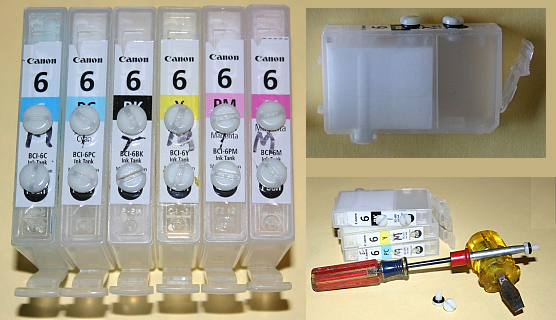
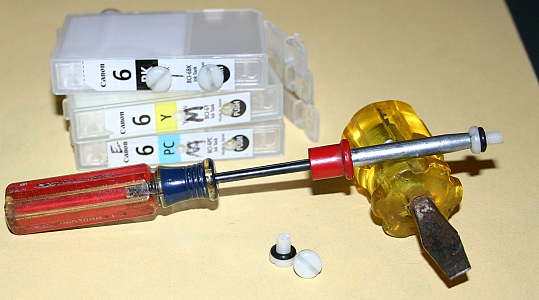
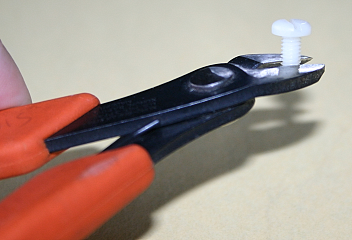
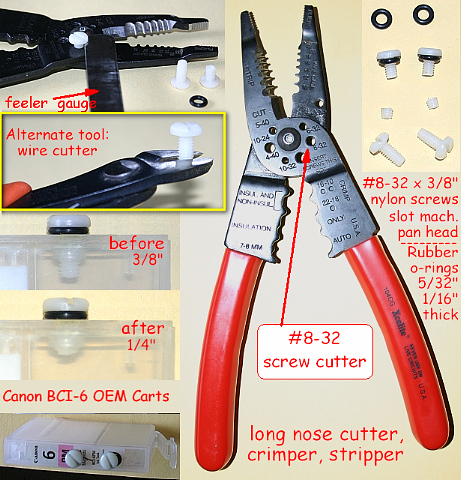

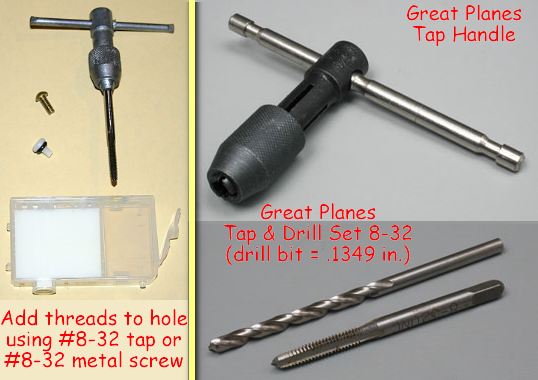
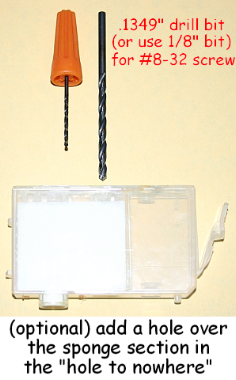
Thought I would throw in my two cent method for “sealing”. I use my hot-melt glue gun. I first run a line of glue around the “hole” and let it cool for just a few seconds. I then shoot a small amount into the center and let it cool for a second. The outer “ring” keeps the 2nd shot of glue from actually running into the tank. After the 2nd shot of glue, while still soft, I gently push down on the glue. A small amount will enter and plug up the hole.
When another refill is needed, the glue “plug” is easily removed by just lifting up the edges and pulling out the plug.
Thereyago…
I tried the hot glue a few times but had poor success. It seemed that if there was even a small amount of ink on the cart that it would prohibit the glue from creating a good enough seal. You can read an excellent thread on the topic here:
http://www.nifty-stuff.com/forum/viewtopic.php?id=28
I’ve settled on the stainless steel pan head screws with o-rings. This has been the easiest and most reliable method I’ve found.
First: only one 3mm hole on the top
Second: Aluminium tape
Simply and easy
Perfect for all time.
Best Regards from Argentina
Found a source of 8-32×1/4 nylon screws, shortcutting (pun intended) the process and this source also sells o-rings
smallparts.com
Items: $4.70
Standard Shipping & Handling: $4.19
Order Total(w/o tax): $8.89
This looks great. I’ve been using hot glue, but often have leaks. One question – does the fiber in the second channel get too saturated to work after several fillings? Also where can I get empty unfilled OEM canon cartridges?
I’ve filled each of my cartridges probably about 15-20 times, and I’ve had no problems with the sponge. I’m not going to bother with cleaning it when / if it goes bad. I’ll just buy another cartridge since I don’t have to do it very often. As for OEM cartridges you can get them at http://www.inksupply.com
This is great info! I have a Canon Pixma printer and the ink cartridges are an arm and a leg. I will definitely try to refill them myself when I’m out of ink. It’s a great printer by the way, the quality images produced are better than the commercial color laser copies that I’ve had done at print shops. Of course it’s an ink jet printer not a laser printer but the quality is really awesome.